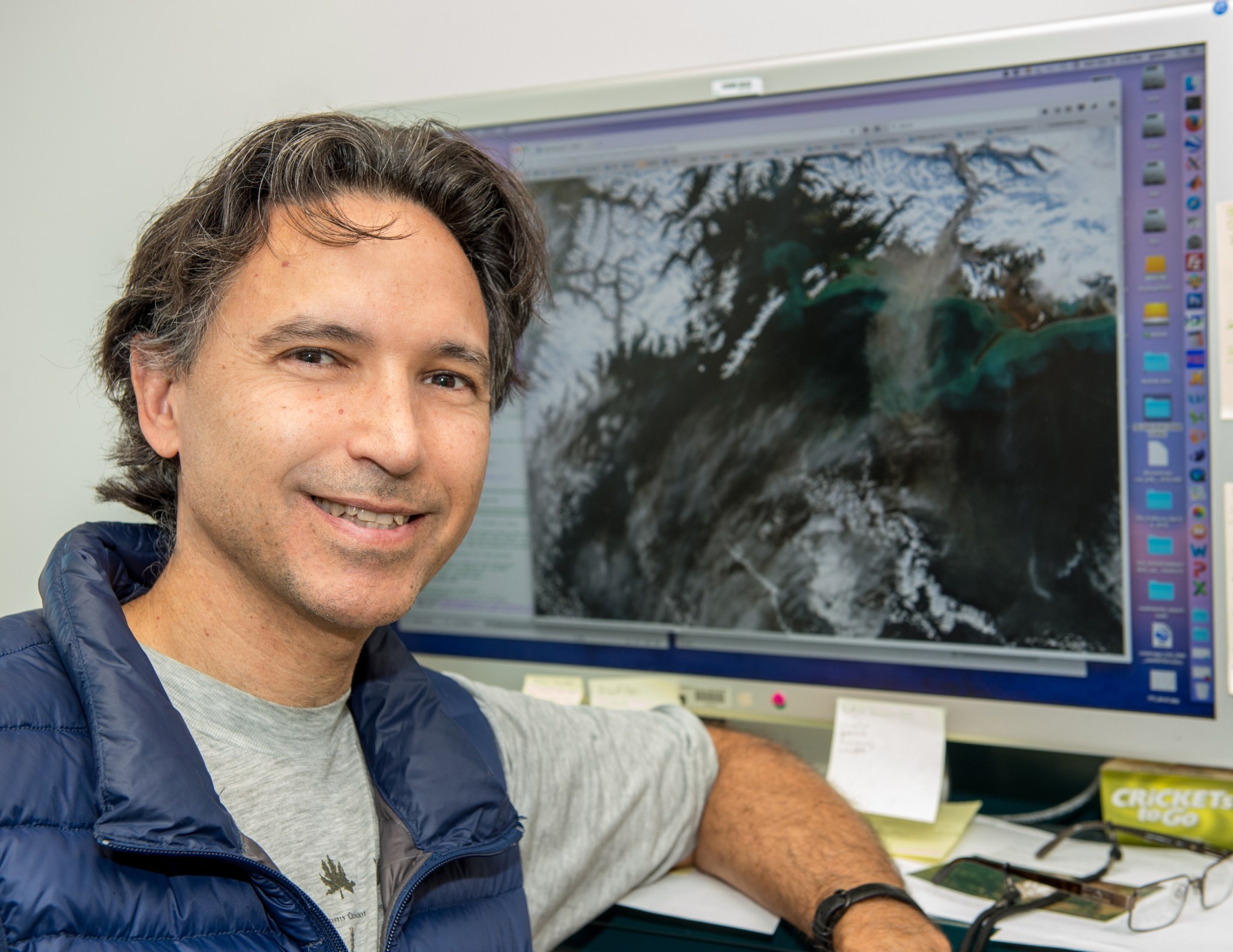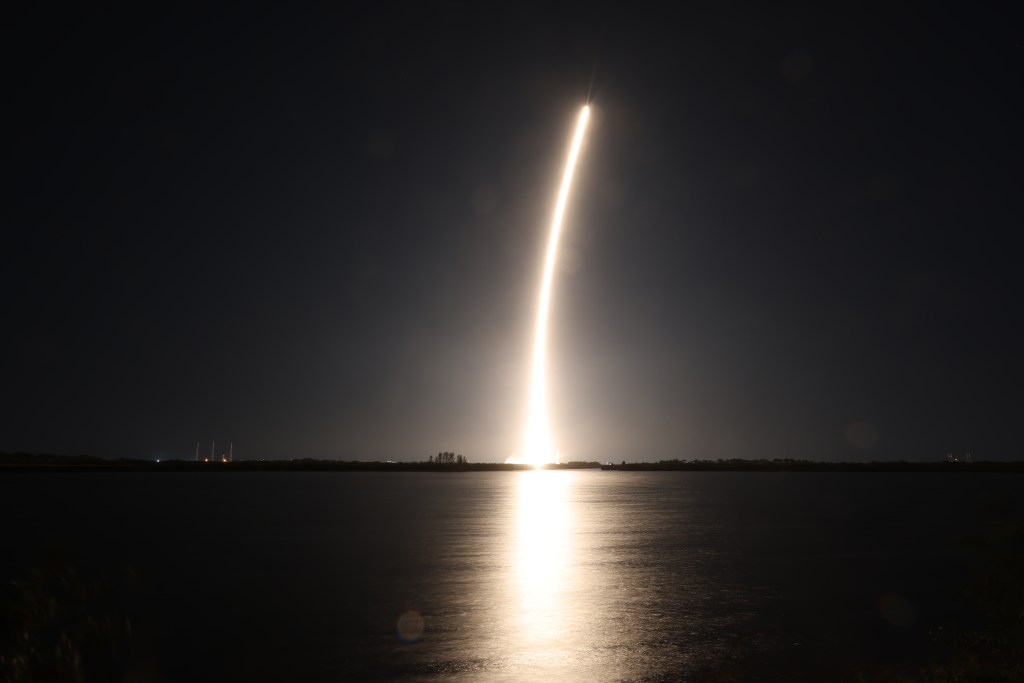Name: Santiago Gassó
Title: Physicist
Organization: Code 613, Climate and Radiation Laboratory, Sciences and Exploration Directorate
Chased Patagonian Dust to Volcanic Belches
What do you do and what is most interesting about your role here at Goddard? How do you help support Goddard’s mission?
I am a physicist and work in atmospheric science with a specialty in remote sensing. I use remote sensing data from satellites to look at the Earth’s atmosphere, and I focus on natural and manmade aerosols, which are very small particulate matter.
I am part of the science team for the Ozone Monitoring Instrument (OMI) on the Aura satellite. Launched in 2004, OMI is an instrument designed to survey pollutants such as sulfur dioxide or aerosols in the Earth’s atmosphere. I am part of the team that develops algorithms based on this data.
You’re from Buenos Aires. How did you come to Goddard?
I was born in Buenos Aires, a city as dense as New York City. I got a master’s in physics from the University of Buenos Aires. Because I wanted to live abroad, I came to the U.S. to get a doctorate in geophysics specializing in atmospheric sciences from the University of Washington in Seattle. I came to Goddard because I wanted to learn radiative transfer theory from the people who designed and created the satellites that I used in the observations I used for my Ph.D. thesis. Radiative transfer is the study of propagation of electromagnetic energy and it provides the framework, and most importantly, the equations that most satellite retrieval algorithms use.
What is your main scientific work at Goddard?
My main objective is to use algorithms to determine how much radiation has been absorbed by atmospheric aerosols. The study of absorption by aerosols is important because it can change the temperature profile of the atmosphere. For example, a thick cloud of smoke can increase the ambient temperature by absorbing solar energy and returning that energy to the environment in the form of heat.
What are some of your other scientific interests at Goddard?
I also like to spend time looking at satellite images for phenomena that were overlooked. For example, I am very interested in dust from glaciers and other high-latitude deserts. Dust plumes coming off Greenland’s and Alaska’s coasts can be clearly seen in satellite images.
I am curious about measuring particulate mass concentration based on these images. I want to know the total amount of this relatively new phenomenon. The implication is that, unlike the more tropical sources of dust like the Sahara Desert, the high-latitude sources are near and upwind of ocean ecosystems with known deficiencies in certain nutrients. It is widely believed that the dust plumes are supplying nutrients, such as iron and phosphorous, that would otherwise not be available in these marine ecosystems. However, we have not yet proven this idea.
I am also beginning to work with astrobiologists to implement or adapt astrobiology remote sensing techniques to study aerosols in the Earth’s atmosphere. This is a new, exciting area for me.
What is your biggest discovery?
About 10 years ago while looking at dust plumes coming off the Patagonia desert in the south end of South America and following these plumes over the south Atlantic, I ran into a very cloudy area with highly distinctive tracks in the clouds. It turns out that I discovered the equivalent of cloud tracks of smoke from ship engines in shipping lanes, except that these tracks were generated by volcanoes. The tracks were formed in clouds moving over very weak volcanic eruptions that normally would not have been seen because the cloudy conditions. Rather than a full eruption, these traces are made from volcanic belches.
When these aerosols reach the cloud deck above the volcano, they change the properties of the clouds slightly. Just like pollution entering a cloud, the volcanic aerosols induce a change in droplet size that results in a change in amount of radiation reflected by the cloud. This is change is what is detected by the satellite.
I found all this just by chasing dust from Patagonia. I just wanted to know how far this dust would go.
Please tell us about your fieldwork in Patagonia.
I have been to Patagonia twice. Both times, I was working with a partner to install equipment to measure dust at the ground, the same dust that we see from space.
Patagonia is a desert in the southern end of Argentina. It is cold, dry and sparsely populated. Patagonia has a fantastic mountain range, the Andes, that is twice as tall as the Rockies.
How have your Patagonian studies evolved?
I was the first person to report observations from space that showed dust storms in Patagonia. I was the first one to study the entire transport of these dust storms using satellites and modeling tools.
This work put me in touch with a diverse group of scientists including geochemists, paleoclimatologists and geomorphologists who are all interested in the presence of dust in high-latitudes, such as in Alaska, Greenland and Iceland, and their impact. We formed a network called the High Latitude Dust and Climate Network that is hosting a symposium two years from now in Iceland.
It is interesting to see how different scientists view time. The satellite data I use is based on many photos per minute. My time reference is very fast. In contrast, some of the paleoclimatologists, who drill cores into the ice, view tens of thousands of years in a single inch. They think in terms of thousands of years.
How did your training make you able to find things no one else sees?
I am always finding things that others have missed. This skill comes from my Ph.D. thesis on measuring how atmospheric particles capture water and grow to become cloud drops. I was one of my adviser’s first Ph.D. students. He did not have much money to buy new equipment, so we had to use observations or data already analyzed by other groups. As a result, I was always getting the leftover data and the datasets I was using had already been mined. The easy things that one could say from them had already been discovered and reported. So, I had to sharpen my skills to discover phenomena and effects that had been overlooked by others.
What motivates your scientific research?
I am always curious about understanding physical concepts and how different phenomena integrate. For example, I want to understand how dust interacts with the ocean biology. Another example is how the ocean interacts with the atmosphere by supplying aerosols. I am a good observer too.
What else do you do to satisfy your curiosity?
I make it a point to attend seminars outside my field. Presently, I am very interested in planetary exploration, so I go to many of their lectures. It is super fun and I learn things that I can apply to my own research. I also read papers from outside my field so that I can learn about other areas. I am interested in many areas, not just my own.
Why did you choose your profession?
I wanted to be a biologist. I became a physicist because it was easier for me to understand equations than to memorize facts. Mathematics makes sense to me.
Who is the most inspiring person you have worked with at Goddard?
One of my thesis advisers was the late Yoram Kauffman. He was a very intelligent and generous scientist, brilliant actually. He was very good at inspiring and encouraging other to explore their instincts, to ask why and then find out the answer. Yoram is the one who inspired me to follow up on the volcano discovery. When I first showed him the faint traces, he was so excited that he said that he could see the image on the front page of Science magazine. Coming from him, that meant everything to me, then a young scientist. Unfortunately, he died about two months later.
What do you do in your spare time?
On weekends, I spend most of my time with my wife and two kids. Every spare minute during the week, I get onto my laptop and look at new satellite images, much to my wife’s chagrin.
By Elizabeth M. Jarrell
NASA’s Goddard Space Flight Center, Greenbelt, Md.

Conversations With Goddard is a collection of Q&A profiles highlighting the breadth and depth of NASA’s Goddard Space Flight Center’s talented and diverse workforce. The Conversations have been published twice a month on average since May 2011. Read past editions on Goddard’s “Our People” webpage.































